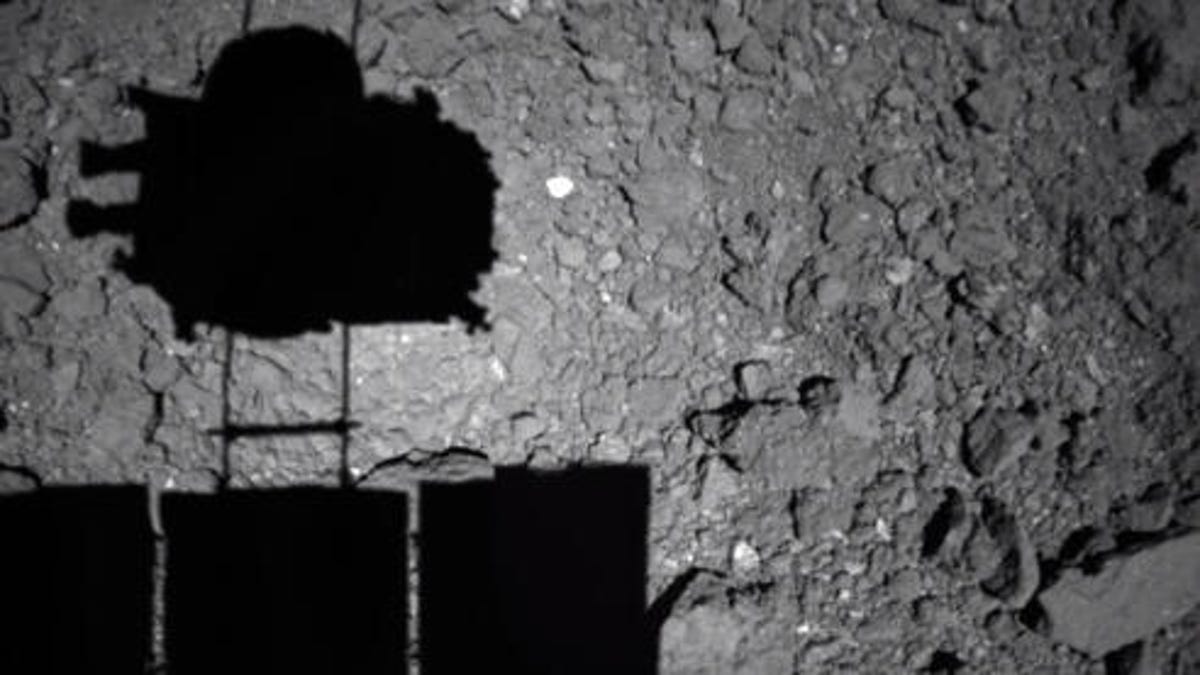Hayabusa2's extreme touchdown on asteroid Ryugu reveals surface secrets
Japan's asteroid chaser discovers Ryugu's been flying a little closer to the sun than expected.

Hayabusa2 touched the surface of asteroid Ryugu -- and filmed the whole thing.
Japan's Hayabusa2 spacecraft is well on its way back to Earth after rendezvousing with asteroid Ryugu about 180 million miles away, but the work it did while orbiting the rocky cosmic vagabond is revealing more of Ryugu's secrets. The latest revelation: It's red and blue in the face -- and now we know why.
Japanese space agency JAXA launched the Hayabusa2 mission in December 2014 and made a beeline for the spinning-top-shaped asteroid Ryugu, which orbits the sun between Earth and Mars. After chasing Ryugu for four years, Hayabusa2 finally made its date with the potentially hazardous space rock in 2018. It's been busy dancing with the asteroid ever since, even dropping two rovers on the rocky surface and a third robot two years ago.
A new study by JAXA scientists and collaborators, published in the journal Science on Thursday, used the high-resolution images taken during a close-up encounter with Ryugu back in February 2019 to uncover a few of the asteroid's secrets. One of the spacecraft's goals was to snatch a sample of the rock that lies on the surface of Ryugu, but to do so, it needed to get a good lay of the land.
Months of surveying Ryugu's surface with onboard cameras led to the daring heist, providing asteroid chasers with a heap of data when the spacecraft finally descended to the surface.
The images snapped by Hayabusa2's telescopic optical navigation camera (ONC-T) enabled the research team to analyze the spectral signature of the asteroid's surface. Previous work had shown how, like an onion or parfait or ogre, Ryugu is made of layers. In particular, two colors stand out in Ryugu's surface materials: red and blue. The asteroid's mostly red around the mid-latitude regions and blue around the equator and at the poles. Impact craters also were quite blue.
However, why such patterning might be the case remained a mystery.
Fortunately, the first snatch and grab moment for Hayabusa2 gave researchers a much sharper look at the surface materials and led the team to believe the red surface material is caused by a little excursion Ryugu took past the sun.
When the spacecraft touched down in February 2019, debris was kicked up and sprayed all over the surface. Ryugu's touchdown location was in an area with more blue surface material, but once it had touched down briefly and taken off again (as quick as a high-five), a layer of dark, fine red grains were littered upon Ryugu's face.
These clues pointed to a solar detour Ryugu may have taken around 300,000 years ago. At that time, Ryugu passed closer to the sun and the heat could have caused materials on the surface to redden.
Over time, forces acting on the surface of the asteroid -- like impacts or wasting -- have mixed the reddish and bluish material on Ryugu's surface together. When Hayabusa2 stole a surface sample, it kicked up a lot of the dark, red grains that had settled.
The good news for the JAXA team is they likely captured both the reddish and bluish material in their surface sampling and can study the material back on Earth.
Hayabusa2 is now on its way home and is scheduled to drop off its space dirt in the Australian outback this December. Post-delivery, Hayabusa2's fate is unclear, but JAXA scientists have suggested it may have its mission extended with a flyby of another asteroid, 2001 WR1, or even find itself on a new mission to observe Venus.

